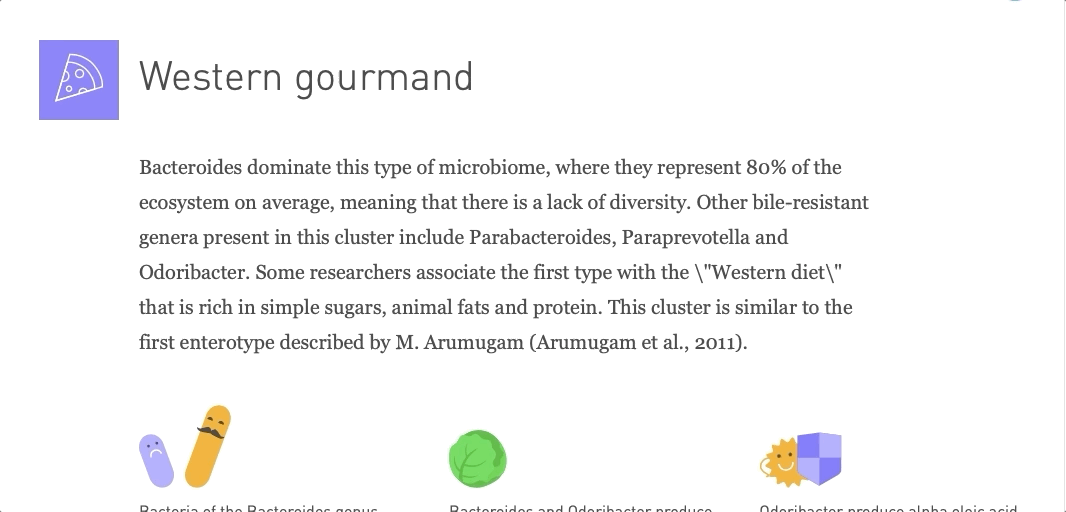The study of human gut bacteria and their functions within the body is a relatively new field. Enterotypes are clusters of bacterial communities in the gut that allow researchers to identify common traits that bring people together.
Fortunately, as in other areas of medicine and science, the microbiome appears to be governed by a set of systems and rules that researchers are working hard to elucidate and prove. The theory of enterotypes suggests that people fall into one of three microbiome categories that is largely associated with their long-term diet. These groups are referred to as “clusters”.
- The microbiome weighs approximately 2.5kg and is composed of trillions of bacterial cells that produce a range of compounds like vitamins and short-chain fatty acids.
- Diversity of microbial species is generally considered an indicator of good health and dysbiosis (the imbalance and/or lack of diversity) tends to signal ill health.
- A person’s eating choices are considered a prime influencer of change in the microbiome, be it positive or negative, as well as the use of pharmaceutical drugs.
Enterotypical controversy
Before launching into the science behind enterotypes, be warned that it is a controversial subject. This is normal for the early stages of any discovery, especially when it comes down to a living, fluid and responsive biological entity like the microbiome. Scientific research, by its nature, can only take a snapshot of one event to investigate, in a universe where time moves and everything changes and responds to everything else.
This is also why “bodies of research”, "large-scale metagenomic studies" and “meta-analyses”, the review and statistical analyses of many research papers with comparable parameters, are preferred yardsticks by which to measure the accuracy of a theory.
Now, imagine your microbiome at home in your daily life with routines and habits that extend over months and years. You eat healthy-ish, you go to bed on time, you do some sports – essentially you try to treat your body well… And then you go on holidays.
The plane lands late, you’ve missed dinner and you can only get fast food. The next day, you treat yourself to a sexy latte with flavoured syrup and croissant, because it is the holidays after all. You have lunch at a random café because by that time you’re too hungry to say no. Later, you snack and then eventually you find a great place to have dinner with a killer wine menu. And two weeks later, you’re ready to get home and eat some “proper” food.
If you were to do a Before and After Microbiome Test with Atlas, our lab would likely detect significant variation in the composition of your microbiome – even after one month. That’s how much diet can affect your gut bacteria.
This is the challenge and controversy surrounding enterotypes. Drawing out immutable rules and identifying systems that organise the human gut microbiome when it is so sensitive to change and the science is nascent, is nothing less than a gargantuan task. Nevertheless, there is currently enough theory and evidence to suggest that enterotypes are a viable direction for microbiome research, and that is why you can find your enterotype in the results of your Atlas Microbiome Test.
Identifying enterotypes and their traits
Enterotypes are stable clusters of bacterial communities that co-exist together. These clusters do not have strict borders. Rather, they are fluid and distinguished by a dominant bacterial community within the person’s microbiome.
Science currently entertains the likelihood and accuracy that a person’s microbiome belongs to one of three clusters: the veggie muncher, the Western gourmand or the grain lover.
Your microbiome's place in one enterotype may vary: some people may be strongly characterised by either plants, animal protein or grain dominance, others may be to a lesser extent. Essentially this means that it is hard to distinguish clear borders for each cluster because the bacterial abundance progressively leans one way or the other.
People are grouped together at distinguishable intervals on this scale based on their proximity to the central point in each cluster. It is also possible to have a “mixed type”, which occurs when your microbiome is located ar a crossover point between 2 two different enterotypes.
The 3 Enterotypes
🥦 Veggie Muncher: Prevotella-dominant types are found in people who consume primarily carbohydrates. Studies currently indicate that this cluster is common for high-fibre whole-food diets with grains, pulses, vegetables and fruit, and people who consume refined carbohydrates like sweets and pastries.
🍔 Western Gourmand: Bacteroides-dominant types are associated with high intake of animal protein and fats, as well as refined sugar. The elevated representation of Bacteroides indicates that this cluster may lack diversity. Some researchers suggest that it may reflect the Western diet and eating habits.
🌽 Grain Lover: this less distinct cluster is dominated by several bacteria, and deemed to be Ruminococcus-dominant in the landmark enterotype study conducted by Arumugam et al. (2011). People in this cluster tend to consume a diet rich in dietary fibre and resistant starches with limited variety, reflecting the dietary choices and stability found in rural, farming communities.
What influences enterotypes
Were you to sustain significant changes in your intake of meat vs. carbohydrates over a long period, it would therefore be probable to see your enterotype move along the scale towards one cluster or another. It is also why we recommend against taking the test within 3 months of antibiotic treatment, use of non-steroidal anti-inflammatories, and surgery – these three factors have also been shown to have strong repercussions on microbiome stability and health for months and even years.
There are also a number of factors that, you might think, could influence enterotypes, but don’t. For example, body mass, age and gender have not been shown to explain the existence of different enterotypes, even though they are significant factors in disease risk assessment for human health.

In addition, while short-term changes in diet can be detected by microbiome analysis, they haven’t been shown to affect a person’s cluster. This was shown by a small controlled feeding study with ten participants. While changes to the microbiome could be detected within 24 hours of a dietary change, the participants’ enterotypes remained stable over the 10-day period of study.
In a forthcoming article this week, we will look more closely at the different enterotypes, dietary influences and various studies that validate the existence of microbiome clusters. In the meantime, you can refresh your memory with this helpful box of enterotype knowledge take-aways from this article.
☝️ Remember
1. Enterotypes are clusters of dominant bacterial communities.
2. Long-term diet and drugs are believed to influence enterotype the most.
3. Prevotella-dominance is associated with carbohydrate consumption.
4. Meat-eating is linked to a strong representation of Bacteroides.
5. Traditional rural diets are represented by several microbial species.
8. Age, gender and body mass don't appear to influence enterotype.
7. Regular microbiome tests can reveal long- and short-term dietary changes.
- Manimozhiyan Arumugam, Jeroen Raes, et al. Nature volume 473 (12 May 2011), Enterotypes of the Human Gut Microbiome.
- Gary D. Wu, Jun Chen, et al. Science Vol. 334 (07 Oct 2011), Linking Long-Term Dietary Patterns with Gut Microbial Enterotypes.
- Vandeputte D, Falony G, Vieira-Silva S, et al. Gut (2016), Stool consistency is strongly associated with gut microbiota richness and composition, enterotypes and bacterial growth rates

















